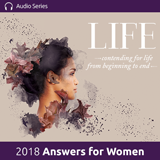
Fearfully and Wonderfully Made: The Anatomy of an Exhibit
Meet the team of artists and writers behind the world’s most pro-life museum exhibit.
On September 25, 2020, the first guests experienced the Creation Museum’s newest exhibit, Fearfully and Wonderfully Made. They marveled at mesmerizing videos of 4D ultrasounds, awe-inspiring details of human development, and stunning lifelike models of babies depicting the nine-month development from fertilization to just before birth.
But just a few miles away, the museum’s design studio was quiet, with the lights turned off, computers dark, and desks deserted. After more than a year of planning, designing, crafting—and several weeks of long days that were necessary to meet the grand opening deadline—the designers and fabricators were taking some well-earned vacation time.
The psalmist declares, “I praise you, for I am fearfully and wonderfully made. Wonderful are your works; my soul knows it very well” (Psalm 139:14). The design team certainly knows. Lead production designer Allen Greene said, “Our team has tried in a small way to fearfully and wonderfully create this exhibit. It’s been a labor of love.”
In the beginning, God formed the first human, Adam, from dust and breathed into him life (Genesis 1:26, 2:7). Creating an exhibit that merely mimics that life was an incredible effort. But the challenge of creating gives these artists a deeper understanding of the Creator.
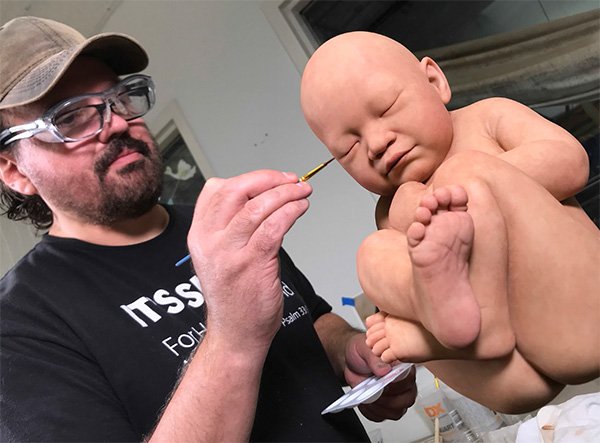
Lead artist Doug Henderson adds details to one of the baby models.
Masterpiece on Display
Fearfully and Wonderfully Made (FAWM) is a bit different from the museum’s other exhibits, which focus on the authority of God’s Word, starting with the six-day creation just over 6,000 years ago. Though Answers in Genesis (the ministry behind both the Creation Museum and the Ark Encounter) has always been pro-life, this is their first exhibit that specifically celebrates the sanctity of human life created in God’s image from fertilization.
“It’s very controversial and very timely,” noted Patrick Marsh, vice president of attractions design. “People get lied to by so many people out in the world about what is a baby. We’ve lost the preciousness of life.”
There’s never been a better time for the Creation Museum to unveil this life-promoting exhibit, to showcase the Creator’s masterpiece—us.
Casting the Vision
From the first vision-casting meeting in May 2019, the team decided that the exhibit would focus on celebrating human life and the fact that we are made in the image of God, rather than focus on abortion. In fact, the word abortion doesn’t appear until halfway through the exhibit.
With their vision in place, it was time to think about the message. Content manager Tim Chaffey met with lead production designer Allen Greene to discuss a strategy for tackling the number of sensitive concepts in a way that would blend with the style proposed by the designers and artists.
Being able to see the details of little babies moving and smiling in the womb gives us insight into our
Creator’s handiwork that no generation before us has ever seen.
—Tim Chaffey, Content Manager
They brainstormed with people of different ages and backgrounds who were committed to the sanctity of life. They met with medical professionals, people involved in pro-life ministries, young women from other countries, parents who adopted, parents of premature babies, and many others. They also viewed footage of 4D ultrasounds, getting a close-up look at how babies grow.
Tim and Allen interviewed expert scientists like Dr. Georgia Purdom (PhD, molecular genetics), Dr. Elizabeth Mitchell (a former obstetrician), and the late Dr. Tommy Mitchell. They also relied on the indispensable expertise of AiG’s anatomist Dr. David Menton (PhD, biology), an award-winning former professor from Washington University’s School of Medicine and a long-time advocate of the unborn. (A plaque honoring Dr. Menton’s lifetime of research that informed this new exhibit is on display for museum visitors.)
In addition to describing the science behind the process of development, the exhibit also addresses other issues, such as adoption, abortion, and what happens after a baby dies—all topics that require a sensitive approach. But it would take more than just words to create an environment that would both inspire wonder at God’s design and communicate God’s comfort and forgiveness.
A Life-Giving Design
The delicate design language of FAWM stands in stark contrast to the other exhibits Allen Greene has worked on, such as the ruggedness of Noah’s workshop at the Ark Encounter and the rusty warehouse textures of the new Relevance of Genesis space in the museum. But as a designer, Allen has learned to be flexible to make his style faithful to whatever message an exhibit means to convey.
I’ve had three kids, and I’ve never understood the kind of stuff that I’m just beginning to peer into.
—Allen Greene, Lead Production Designer
“We are God’s art,” Allen explained. “So this exhibit is a celebration of creativity and art.” The walls feature soft watercolor textures and cursive font. At the entrance, the exhibit’s sign features a unique lighting effect, pulsating with the slow, calming tempo of breathing or a heartbeat. That was graphic designer Jenelle Cervenka’s idea.
Jenelle said she designed the walls and signs for the exhibit with one thing in mind: “We wanted it to be a space that would be healing and truly be pro-life, and not in just the terms you might think of, but truly be life-giving.”
Studying anything God made gives you a deeper
understanding of who he is.
—Jenelle Cervenka, Graphic Designer
The team knew that some guests who would visit the exhibit would have lost a child through miscarriage or some other tragedy, and even some who might have chosen to abort their baby.
Jenelle’s past work at a support clinic for women facing unexpected pregnancies allowed her to lend a first-hand perspective of the challenges these women face.
“They are usually afraid and lack the support they need. Knowing this, I thought it very important for the [exhibit] space to be gentle and genuine.”
The sensitive atmosphere Allen and Jenelle created prepares guests to appreciate the main attraction—the stunningly lifelike model babies.
Making Babies
Instead of sculpting nine models, one for each month, the team sculpted twelve, representing the baby’s age when certain features are developing, particularly features that people often identify with personhood. For example, one model corresponds to the age when the heart begins to beat and another to the age when fingerprints appear.
Rather than purchasing models of babies from an outside source, lead artist Doug Henderson wanted to design his own that he could pose as if they’d been moving and changing in the womb.
For 20 years, Doug has sculpted likenesses for museums around the world, among them sculptures of Kentucky Fried Chicken’s Colonel Sanders, baseball legend Roberto Clemente, and actor Matthew McConaughey.
But the babies for the FAWM exhibit were probably the hardest human models he’s ever worked on.
“Making something that looks like what God has made is one of the most difficult things you could possibly do,” Doug said. “The difference between something that looks like a baby and an actual baby is like the difference between a photo of a skyscraper and a skyscraper. No matter how good of a job we do, it’s not even comparing to what God has done.”
But guests at the exhibit who leave with a tissue pressed against their tears testify to the team’s masterful ability to replicate the Creator’s elaborate design.
Getting Started

From fertilization to full term, the lifelike baby models give guests a peek at the process of life.
Each of the baby models began on a computer screen. Studying the footage of 4D ultrasounds, consulting medical textbooks, and seeking Dr. Menton’s expertise, exhibit artist Eric Remus created a digital sculpture of each model in a 3D modeling program called ZBrush.
Next, using a 3D printer, Eric printed the sculptures out of resin. The printed sculptures came out with a slightly uneven texture. Unlike the Ark Encounter animals Doug and his crew sculpted in the past, a model of a baby has no scales or feathers to hide imperfections. A baby’s skin is smooth, so the sculptures had to be carefully sanded, with any cracks filled in with modeling putty. Too much sanding could flatten a curve or round a straight edge.
From his years of sculpting, Doug knows the importance of precision. “The differences look big until you start measuring and realize that we’re all very tiny bits different from each other. A millimeter on a model can make a huge difference.”
First Things First
Next, the design team used the sculptures to make precise molds that would hold the material necessary to form the models.
The first model doesn’t actually look like a baby at all. But that’s because the designers chose to replicate the first part of life—fertilization, when the DNA in the father’s sperm combines with the mother’s DNA within the egg to create the unique combination of information necessary for an individual human.
The first eight models were made of clear resin, carefully custom tinted by exhibit artist Jesse Pié to get just the right translucency of an embryo. Then, starting with the ninth model, the babies were cast from flexible silicone, better for showing a growing baby on the move.
But Doug was puzzled over how to mold the silicone babies without showing seams all over. One night, in a dream, he pictured a mold with only one slit in the back. When the silicone had cured (hardened), the team could crack open the seam and “birth” the baby out the back.
Easier dreamed than done. The process was more like a nightmare. Due to chemistry problems with the material, the team was left with only one good copy of each of the last four models. Time was closing in, and the final deadline had to be met. Yet some of those castings had to be patched with more of the silicone used to cast them. Silicone is temperamental, requiring exact conditions to cure. The team learned that silicone was “allergic,” as Doug called it, to their nitrile gloves and to latex. With even a small latex rubber band in the room, the silicone refused to cure.
“If this was my first experience, I would have said I need to find something else to do for a living,” Doug confessed. “It was the worst experience of my entire career.”
When a silicone model cured, Doug poured in a liquid soap to help loosen the silicone from the mold. Even then, the models sometimes came out with parts of the mold attached and other times the model left behind bits of fingers or toes in the mold and even a chunk from the neck.
When it came time to mold the full-term baby, the silicone cured on the outside of the model but not the inside. Just weeks out from the exhibit opening, the model looked like a baby-shaped bag of pudding. So he wrapped it in plastic wrap and propped it up. Eventually, the silicone cured—but it bore a wrinkled texture all over from the imprint of the plastic wrap. He had to resculpt the surface out of silicone.
Once the babies were molded, Doug and his team scooped the silicone out of the floppy sculptures and threaded wires into the arms and legs to make them posable. Next they poured resin inside to anchor the wires.
Sounds of Life
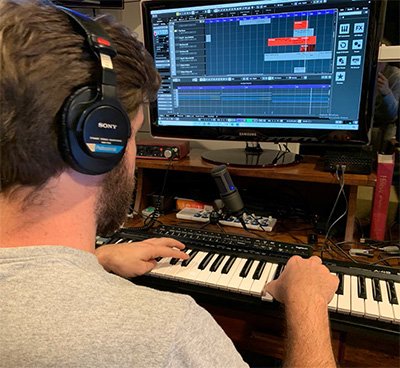
Production designer Ben Iocco composed the exhibit soundtrack to help guests experience the wonder of life.
Benjamin Iocco has been fascinated with sound his whole life. As a boy, he took a tape recorder outside and recorded sounds in nature for hours. When he was 12, he started composing his own music. “I love telling stories,” Ben said. “Music is one of the best story languages.”
Ben is a production designer with Answers in Genesis attractions, not a full-time composer. But in 2019, Ben composed music for the Biblical Authority exhibit at the Creation Museum. It seemed a natural fit, then, for him to compose music for Fearfully and Wonderfully Made.
First, Ben learned what kind of message the designers wanted to reflect in the exhibit. Then he collected and tested sounds that captured the mood and emotion. “I look for the right sonic blend to tell a story. I wanted to reflect a feeling of wonder and beauty as well as a simplistic familiarity and intimacy.”
He settled on sounds of the piano to bring an intimate feel, with ambient textures in the background to give a sense of awe. He meant the underlying rhythm to replicate a heartbeat and the softness to resemble the way a baby hears sound within the mother’s womb.
Though you won’t see Ben’s design, his creativity plays a large part in preparing guests to receive the message. “I just hope the music allows the guest to reflect on the wonder of life.”
Final Touches
When all the models were finally molded, Doug’s team set up a “clean room” where he could add his final touches in a dust-free environment. Someone hung the word nursery in pink and blue letters above the big windows in the front of the room. For weeks anyone passing by could watch Doug daubing the babies with flesh tone paints.
Doug claims he’s always resented sleep. “Why would I be sleeping when I could be making something?” His nonchalant relationship with rest serves him well. For weeks, he spent 10–14 hours a day, seven days a week, working on the models. The pace caught up with him while he was painting. He shuddered. “The most unforgiving, valuable thing I ever painted, and I fell asleep right in the middle of painting.”
The Fine Details
To represent the fact that there is truly only one race of humans, the designers intended for the babies to be ethnically ambiguous, referencing a variety of genetic traits. The dark hair they decided to use meant a tedious task for the workers who would be punching (inserting) each individual hair into the silicone heads.
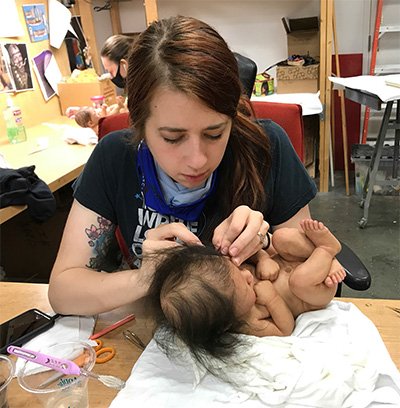
Amber Harbin, along with other exhibit artists, meticulously punched in each individual hair on the baby models.
While trying to decide which kind of hair would work best on the models, Doug ordered a bag of yearling goat hair for $60. The bag that arrived was the size of a sandwich baggie. “That’s ridiculous,” he thought. There had to be a less expensive option. One day, while walking through the fabrication rooms in the studio, he spotted some yak skins, most likely left over from the team’s work on the Ark Encounter animals in 2016.
Doug showed a small team of designers how to punch hair. After cleaning and coloring the yak hair, they practiced punching it into the silicone heads. The designers learned to appreciate the complexity of growth patterns as well as the varying density and length across the head, reflecting often on the knowledge that God numbers the hairs on our heads.
A professional who punches hair into models like these on a regular basis takes 33 hours for one head of hair. But the complications with the silicone models had left the designers with under two weeks to punch hair into the baby models. The work was worth it. The silky hair adds a final touch that makes these models look like real babies, adding to the wonder of life.
Allen hopes these specific details will inspire each guest in individual ways. “For one person it might be a choice to let their baby live instead of taking the baby’s life. For another person it might be to find the eternal life God gives through the gospel. For another person it might be they’ve had a miscarriage and they see the hope of the gospel in that situation. Others might be contemplating suicide and see that they are fearfully and wonderfully made—that their life is valuable because they are God’s creation.”
Secrets on Display
“By the time you’re at the end [of designing an exhibit], you think, ‘I’ll never do that again.’” Doug chuckled. “And about a week later you think, ‘That wasn’t that bad. I could do that again.’”
And the design team will do it again.

In 2021, the Fearfully and Wonderfully Made exhibit will be expanded and moved to a permanent exhibit space.
Fearfully and Wonderfully Made is the first phase of an expanded exhibit which, if all goes as planned, will open later this year at the Creation Museum. Though the message of life will be the same, the expanded exhibit will include more technology, more of the lifelike models of babies in different stages of development, and more educational aspects, such as a section exploring the placenta’s amazing design.
The Psalmist said we are “made in secret, intricately woven in the depths of the earth” (Psalm 139:15). But some of those secrets are now on display, exquisitely crafted to give guests a greater appreciation of life created in the image of the Creator.
Matchless Wonder
Far from merely a clump of cells or a blob of tissue inside the mother’s womb, a baby displays incredible complexity and purposeful design. The process of human development from fertilized egg to birth is a matchless wonder revealing the Creator’s awe-inspiring creativity and care.
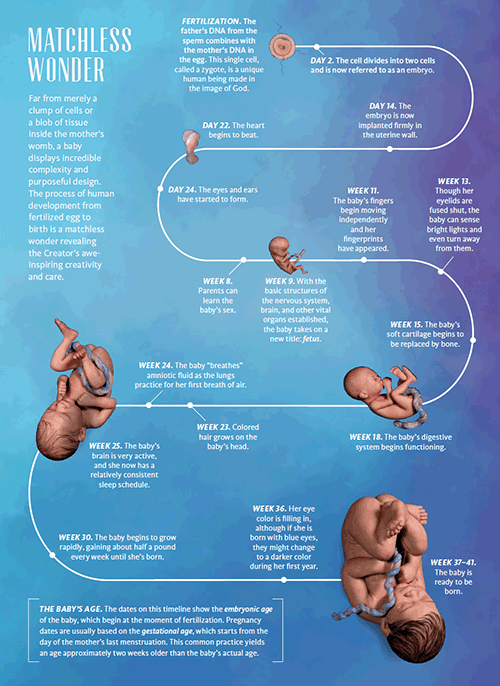
THE BABY’S AGE. The dates on this timeline show the embryonic age of the baby, which begin at the moment of fertilization. Pregnancy dates are usually based on the gestational age, which starts from the day of the mother’s last menstruation. This common practice yields an age approximately two weeks older than the baby’s actual age. Click image to enlarge.
Answers Magazine
January–March 2021
Meet the team of artists and writers behind the world’s most pro-life museum exhibit.
Browse Issue SubscribeRecommended Resources

Answers in Genesis is an apologetics ministry, dedicated to helping Christians defend their faith and proclaim the good news of Jesus Christ.
- Customer Service 800.778.3390
- © 2024 Answers in Genesis





